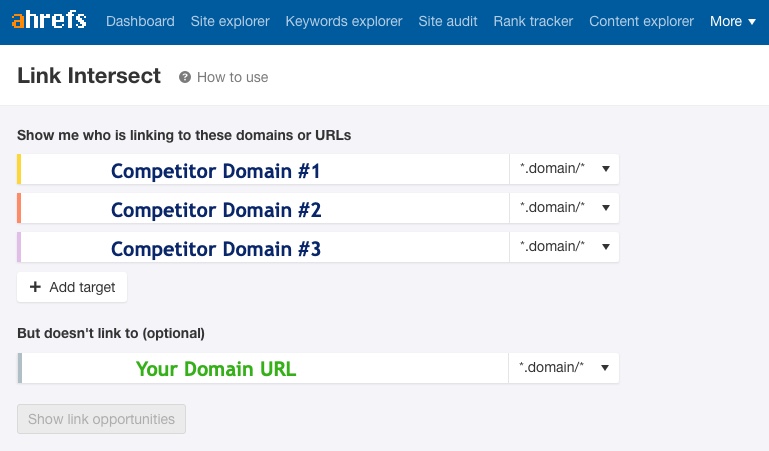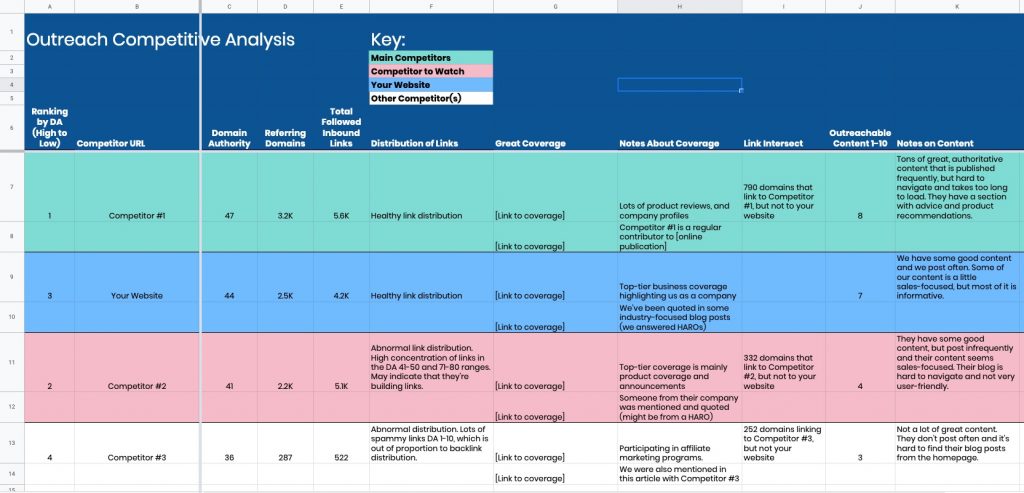Forming an off-page SEO strategy is necessary before you actually get to work. But even before you create your strategy, you’ll want to know what you’re up against so you can use tactics that will be effective against the competition.
An off-page SEO competitive analysis will do exactly that—show you what your competitors are doing so you can plan to get ahead. It’ll help you identify their strengths and weaknesses and give you insight into the tactics they’re using. Ultimately, it will help you figure out what you need to be doing so you can outshine (and outrank) your competitors.
Helpful Competitive Analysis Tools
While your brain is obviously your most powerful resource, having a couple of other tools in your belt will make the process much more efficient. The best SEO tools for executing a competitive analysis are Moz and Ahrefs. You can get by with just one of these, but will gain the best insights by using a combination of both. We’ll specify how to best use each of these tools below.
What to Evaluate in an Off-Page SEO Competitive Analysis
You’ll need to look at more than one thing to determine how big a threat each competitor is to you. Here are the most important factors to consider, and which tool will give you the information you are searching for.
Domain Authority (Moz)
If you’re not already familiar with it, Domain Authority (DA) is a metric that will help you see how you rank compared to your competitors. It ranks sites on a scale between 1 and 100. Generally, you want your site’s DA to be as high as possible.
But don’t get too caught up in worrying that you have too low of a DA—it’s a relative metric that you should use to compare your site to your competitors.’ You want to see what DA range your competitors fall under so you know where your DA needs to be. If you’re looking at five competitors with DAs of 49, 53, 46, 51, and 50, your site’s DA should be at least 46 if you’re going to rank among them. If your top competitor has a DA of 53, that’s what you want to beat.
Number of Followed Inbound Links (Moz)
Links are a top ranking factor for Google and will help boost your SEO efforts. When it comes to links, typically, the more the merrier. See how you compare to your competitors for the total number of backlinks referring to your site.
Number of Referring Domains (Moz)
While links alone are great, having links on unique domains will do more for your SEO than having multiple links on the same domain. See how many unique referring domains your competitors have as compared to your own site.
If a competitor has 1,000 links on 200 domains and another competitor has 1,000 links on 500 domains, the one with 500 domains likely gains more SEO benefits. You’ll want to look at those 500 domains as the number to beat.
Number of Broken Links (Ahrefs)
Broken links don’t provide value or a great experience for the user, and their SEO value isn’t as impactful. You want to have as few broken backlinks as possible on your own site and always fewer than your competitors.
This can also be an opportunity for you to pull a list of your competitors’ broken backlinks and do some broken link building or use a list of broken links on your own site to do link reclamation.
Link Distribution (Moz)
Link distribution can show you if there are spammy links or if a competitor may be involved in paid or black-hat link building tactics. You want to aim for a healthy, natural link distribution.

Exceptional Coverage and Links (Ahrefs, Moz)
Filter through the list of backlinks for each competitor and see if they have any exceptional, high-authority coverage or links. Did they get a link on Forbes or CNN? Or did they receive coverage on a top website in your industry?
Take note of some of their top links and the anchor text of those links, and theorize about how they got them. Look for patterns in each competitor’s coverage, such as:
- Does a single page on their site have tens or hundreds of links pointing back to it within a short amount of time? Or was a survey or original data on their site referenced? They’re likely doing content promotion.
- Has someone from their company been quoted in several articles? They might be answering HAROs.
- Was an article on another website written by your competitor? Has the same person been authoring content offsite and linking back to your competitor in several articles on different sites? They’re doing guest posting, regular contributorships, or content collaborations.
This will show you what tactics they might be using, so you’ll know what you need to be doing. It also shows you what you’re competitors AREN’T doing, which means you may have the advantage. Your competitors might be answering HAROs and doing guest posting, but they may not be doing content promotion. That would be an opportunity for you to jump on content promotion and get a mass amount of links before your competitors know what hit them.
Link Intersect (Ahrefs)
Using the Ahrefs Link Intersect tool will show you how many domains are linking to your competitors, but not to you. This shows where your opportunities are and on which domains you should focus on getting links and coverage.

Linkworthy Content
Study the content your competitors are producing and rate it on how “linkworthy” it is. “Linkworthy” content is content that’s easy to link to. This is generally some type of evergreen, newsworthy content, like a survey, original data analysis, or a helpful, in-depth guide. It could even just be blog posts with really high-level, authoritative content. Linkworthy content helps show your expertise and authority in the field without being “salesy” or overly-promotional. You can use a rating system of your choice; just make sure it’s easy to follow and compare (i.e., a scale of 1-10, with 10 being the great, linkworthy content).
This will give you an idea of what kind of content you need to have and how you can make your content better and more linkable and more linkworthy than your competitors.’ Can you beat a report or guide they’ve produced and then promote it to get coverage? Or is there a unique way you can analyze some data and showcase it with cool designs that can be shared easily? You’ll have a sense of what kind of content other sites are linking to, and you’ll have to get creative in making your content better.
How to Keep Track of Competitor Information
You’ll want to have all of your competitor information kept in one place. Using a simple spreadsheet that includes all competitors will make it easy to compare them side by side.

Once you have all of the information mentioned above, you can rank your competitors from the most to least competitive. The most competitive are the ones you’ll want to keep a close eye on. Depending on how your site compares to the least competitive one(s) on your list, you may not have reason to worry about their off-page SEO efforts if they aren’t doing much.
Choose a couple of your top competitors to watch and stay up-to-date on the tactics they’re using to see how you can improve and overtake them. Keep track of their Domain Authority and take special note if it goes up to see what may have sparked the increase. Once a month is a good cadence for checking up on DA and seeing how you line up with your competitors.
Now, Check Out Your Competitors!
Now that you know what to look for and where to find it, you can start analyzing your competitors. Once you know what they’re doing, you can work on forming an off-page SEO strategy that will leave your competitors in the dust!









